Home » Develop a Healthy Strategy
Legal product reviews and business guidance from industry experts.
Develop a Healthy Strategy
Start with a solid foundation to create the right business.
A healthy business doesn’t just happen. You have to be intentional about what you are building and why you are building it. A law firm strategy is more than a consultant’s catchphrase—this is the plan for how you will empower your team and create the business of your dreams. This is the foundation for everything your business does.
What we can help you with?



